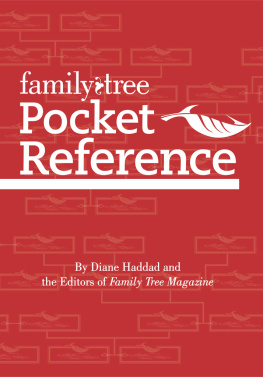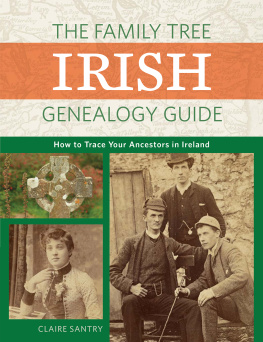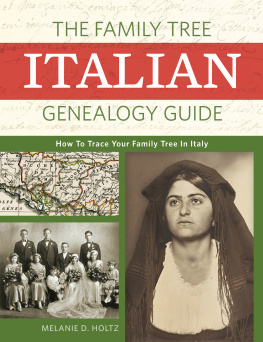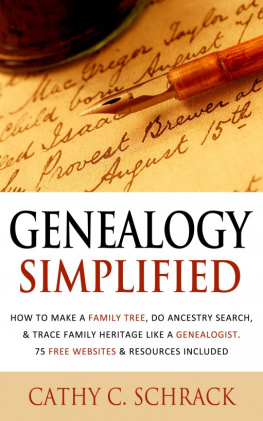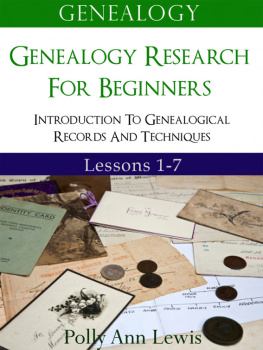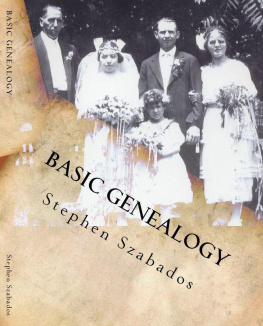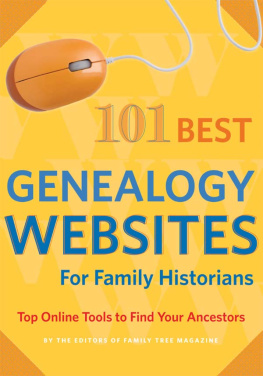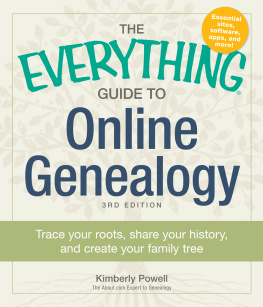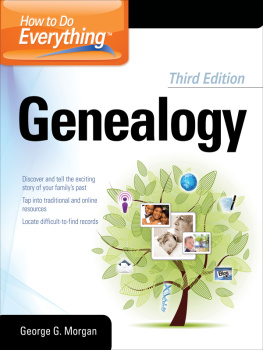Maybe youre knee-deep in genealogy research at your local library when you come across a strange term. Maybe youre in a court records class and the instructor throws out an unfamiliar acronym. Or perhaps youre searching the census on Ancestry.com when you realize you need the census date to calculate your great-grandfathers age.
You could stop what youre doing and search for the right book or website to get the definition or date you need. Or you could pull out your handy Family Tree Factbook, look up what you need to know, and get on with your research.
Weve gathered key resource lists, definitions, dates and other important reference information from Family Tree Magazine and FamilyTreeMagazine.com and put it all into this handy guide. Keep it in your library tote bag or top desk drawer for easy reference.
HOW TO USE THIS BOOK
Check the table of contents to familiarize yourself with the information in this book. When you come across a genealogy word or acronym you dont know, need a statehood date, want to try a new website, wonder about the origin of a surname, have to calculate a Soundex code, need to know whether a family tree program is available for a Mac, want to learn how common your national heritage is, or need other pertinent information, just check the table of contents to find the appropriate chapter and section you need. Whenever your research uncovers a new resource or information thats pertinent to your family history, use the handy forms provided in the appendices. These forms are designed especially for you to record your favorite reference material and newly discovered information.
RESEARCH BASICS
Genealogy Glossary
A
abstract: An abbreviated transcription of a document that includes the date of the record and every name in it; it may also provide relationships of the people mentioned.
admixture: Ancestry that originates from more than one ethnic group.
Ahnentafel: German for ancestor table, this system of pedigree chart numbering gives each ancestor a number. Fathers are even numbers; mothers, odd. Double the childs number to get the fathers (if youre 1, your father is 2). Add one to the fathers number to get the mothers (your mother is 3).
aliquot parts: In the rectangular survey system, a description for a subdivision of a section of land using directions and fractions to indicate the lands location: W12 SE14 represents the west half of the southeast quarter of a township.
allele result: Also called a marker value, the numeric value assigned to a genetic marker.
ancestors: Relatives you descend from directly, including parents, grandparents, great-grandparents and so on.
autosomal DNA: Genetic material inherited equally from mother and father, representing all your DNA except whats in the mitochondria and on the X and Y chromosomes. Autosomal DNA is the most widely used type of DNA in genealogy, as it can estimate ethnic origins and establish genetic relationships between test-takers.
B
banns (or marriage banns): Church documents publicly stating a couples intent to marry.
block number: A one-, two-, or three-digit number that describes a block (or piece) of land within a township.
bond: A written, signed, and witnessed agreement requiring someone to pay a specified amount of money by a given date.
bounty land: Land granted by the Colonial and federal governments as a reward for military service; bounty land warrantsdocuments granting the right to the landwere assigned to soldiers, their heirs, or other individuals.
Bureau of Land Management General Land Office (GLO): The US government office historically in charge of dispersing public land. Usually, several branch land offices existed for each state; its website has a database with digitized federal land patents.
C
cemetery records: Records of those buried, as well as maps of grave sites; usually kept by cemetery caretakers.
census: An official count of the population in a given area; other details, such as names, ages, citizenship status and ethnic background of individuals, may be recorded. The US government has been collecting census data every ten years since in 1790. Many states have conducted their own censuses as well.
certified copy: A record copy made and attested to by custodians of the original who are authorized to give copies.
chromosome: A threadlike strand of DNA that carries genes and transmits hereditary information. Humans have forty-six chromosomes, organized into twenty-three pairs.
citation: The formatted information about a genealogical source that connects that source to each piece of family information it provides.
cluster genealogy: Studying your ancestor as part of a group of relatives, friends, neighbors, coworkers, and associates; this approach can help you learn details you might miss by looking only at records of an individual ancestor.
collateral relative: Any kin who arent in your direct line, such as siblings, aunts, uncles, and cousins.
confidence range or confidence interval: Measure of how likely a result is to be accurate. A DNA results report shows the most likely ancestry percentages (for a biogeographic test) or date an MRCA lived (for a Y-DNA test), as well as a confidence range showing other possible results.
credit patent: A document transferring land to be paid for in installments over a four-year period. A delinquent payment or nonpayment of the full balance resulted in forfeiture.
D
declaration of intention: An aliens sworn statement that he or she wants to become a US citizen, also called first papers; these court records list details such as name, age, occupation, birthplace, and last foreign residence.
deed: A document transferring ownership and title of property; unlike a patent, a deed records the sale of property from one private individual to another.
derivative record: A document that has been copied, digitized, summarized, abstracted, extracted, indexed, transcribed, or otherwise created from another source. Try to track derivative records to the original. When you must use a derivative source, be sure to cite appropriately.
descendant chart: A report displaying names and information on a persons children, grandchildren, great-grandchildren, etc.
descendants: An ancestors offspringchildren, grandchildren, and every new generation in the direct line.
direct evidence: Information in a source that directly answers a research question. For example, if the research question was What was his birth date? then direct evidence of that answer would be a record stating the birth date as 12 May 1835.
DNA: The molecule that contains genetic code. Short for deoxyribonucleic acid; genetic genealogy tests analyze various types of DNA, especially Y-DNA, mtDNA, or autosomal DNA.
documentation


